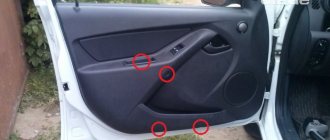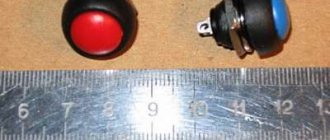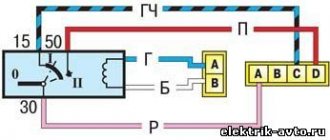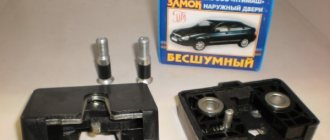VAZ 2106 car, you need to install central locking, install actuators in the front doors.
At the same time, you need to replace the wires of the power window drive. In order to perform such operations we will need the following tools:
- drill and drill bits,
- screwdriver,
- pliers,
- wire cutters and soldering iron.
We will also need a central lock, fastenings and upholstery (about 20 pieces), a post-door adapter tube, female-male terminals, heat-shrinkable casing and wires will also come in handy.
What is required to install a central lock on a door?
- A working and installed car alarm system with power outputs for controlling door locks.
- Activators, actuators, actuators, solenoids, electric drives or, finally, just central locks - 2 pcs.
- The wires are two-core, copper. The diameter or cross-section of each wire must be at least 0.75 square. Length about 3-4 meters.
- Plastic clamps – 10 pieces, maybe more, “in reserve”.
- Other: electrical tape, heat shrink tubing, wire cutters, screwdriver, soldering iron, solder, multimeter, drill, drill bits, electrical extension cord, etc.
Before we begin directly installing central locks, we will analyze each point above in order, in more detail.
1) In this article we will not talk about how to install an alarm yourself, but we will assume that it is already installed. The cheapest option (about 1300 rubles) is a simple alarm without feedback.
Which model to choose, how to connect correctly, how much it costs and other questions about car alarms will be discussed in another article. Just a few important points to keep in mind.
Firstly, the main alarm unit must have a connector (usually 6-pin) with power outputs for connecting door locks. Secondly, before purchasing, decide in advance whether you need an additional alarm channel. It can be used to open the trunk or, for example, implement the “light path” function and other similar functions. It all depends on your imagination and ideas, so it’s up to you. 2)
Lock activators are not called by any name, so don’t be surprised by so many names. We will stick to this term. The central locking solenoid most likely refers to an electromagnet, which is most often installed to open the trunk. In terms of power (traction force) it is much stronger than plastic activators, but it is also more expensive.
The approximate price for a regular central locking activator with 2 outputs (two-wire electric lock) is 100-120 rubles. a piece. For 2 doors you will need two activators, the total cost is about 250 rubles. The kit for each activator includes a special strip for attaching the central lock and self-tapping screws, as well as a rod, screws and a metal retaining plate.
3) To save insulating tape, copper wires in general insulation around the insulated conductors, but you can also buy them separately (single-core). The cross-section of the conductor must be at least 0.75 square. The current consumption of a conventional electric central locking drive can reach 5A at its peak.
In auto stores you can choose wires of various diameters, colors and lengths. Some are sold in ready-made installation kits or kits. Individually or “by meter,” most often, single (single) wires are found.
We recommend going to a regular electrical supply store and purchasing a two-conductor copper cable (the individual wire of which has a stranded conductor). For example, a PVS 2×0.75 cable (with a polyvinyl chloride sheath) or a PVS 2×1 mm cable is suitable. These wires are used to connect various electrical appliances, power tools and other machines and devices. The cost is about 12-15 rubles per 1 meter.
You can look for special automotive PGVA wires, which are intended for automotive equipment and instruments. They also have polyvinyl chloride insulation and are undoubtedly suitable for connecting central locks.
For reference: PGVA wires are designed for flexible connection of electrical equipment and devices with a low rated voltage (up to 48 V) in temperate, tropical and cold climates. PGVA wire is resistant to vibration loads, cracking, gasoline and oils. When laid alone, it does not spread fire.
When installing additional devices and using a second alarm channel, carefully study the table with permissible current loads. Most likely, to install a powerful solenoid that will open the trunk lock, an additional unloading relay will be required.
4)
Plastic tape clamps will be needed to secure the wires. Purchase at will, 10 pieces will be enough.
A set of 100 pieces measuring 2.5×100 costs about 50 rubles.
5) Other tools, devices and materials that may be needed during installation.
Silent locks for VAZ 2106
If you were thinking about making the operation of your “swallow” even more comfortable, you can install silent locks. The doors on your car will close as quietly as on foreign cars.
Before installing silent locks on a VAZ 2106, we purchase the components we need and prepare the tools. We will need:
- 2 sets of silent locks (2 pieces in one set);
- Silent fingers;
- Hex screwdriver;
- Crosshead screwdriver.
Set of silent locks
Installation process
Before installation, we remove old locks from all doors. We take a new lock and carefully saw off the flag. We attach the lock to the door, mark the location of the hole, and then carefully drill it with a drill, adjusting it to the size we need. And finally, we install the new mechanism in its rightful place. We assemble the castle itself, connecting it to the “chocolate”.
After these manipulations, we try to close the door. It turned out great! It didn’t work out - let’s look and check what’s wrong. It may be necessary to recess the lock more, file it, or the problem is in the “chocolate”.
Installation of a silent lock
Let's move on to installing the screw. It must be installed on a stand. To do this, we will again resort to using a drill. In this case, it is very important to correctly and accurately measure where it should be.
Screw installation
We make holes in the front wall of the rack with a diameter of 11 millimeters and in the second with a diameter of 9. We cut the thread and tighten the screw. Now you can try closing and opening the door. If you took all the measurements carefully, then everything should be fine. But you may need small adjustments. In this case, everything is very individual.
Installation of drives, handles
The next step is to install the lock drives and handles. We take the side handle drive rod from the lock that we removed at the beginning. We bend it on both sides, on one side it should be ninety degrees, on the other - a ring. You can install it in place and check it.
Well, the last moment, we connect the internal handle. We drill out the pin in the internal door lock, run the cable and use clamps to make a loop. This is necessary to ensure that the lock does not open on its own while moving.
Loop on the lock
If the doors work properly, then we can congratulate you for doing it yourself. All is ready. If you had alarm activators installed on your old locks, you can safely connect them.
Methods for connecting the central lock
Installing a central lock on a VAZ 2107 can be done in two versions:
- together with alarm system (without central locking control unit);
- with central locking control unit.
In the first case, you will have to install an alarm with a unit that supports the function of direct control of the lock drives. This will save on the purchase and installation of a separate central locking unit. In the second case, you will have to spend money on a control unit, but the central locking can be coordinated with any type of alarm or even used without it (for example, to lock and unlock all doors by turning the key in the driver's door lock).
Installation of motors
In order to install the motors we need, we will have to drill holes in each door. We recommend that you install VAZ 2107 locks, starting with the rear doors.
To get started, remove all unnecessary elements: plastic lining and casing. Take a drill and make a hole in the door. Through it we will subsequently pull the wiring from the stand to the door. Drill a second hole in the rack. Now let's start drawing the wires. Don't forget to use corrugation.
Read, it may come in handy: The sound signal does not work on the VAZ 7 model: diagram, repair, how to make a pneumatic horn
Rear door wiring
Now you can install the engine. When installing, do not forget to check that it does not interfere with the operation of the glass. It's a small matter. We fasten the motor rod and the lock lock rod to each other using a bar. It should be included with the central locking system. Now, actually, it's ready. Let's move on to the front doors.
Installing motors on the front doors will not take much time. In this case, we place them in the left and, accordingly, the lower right corners of the doors. We install according to the example of the rear doors and perform a test.
Installing engines on the front doors
How to connect the central locking to the alarm system?
Since the VAZ 2101-2107 car is not initially equipped with a central locking or electric door lock drives, you can install additional electric drives and connect them to the system as follows.
Central locking connection diagram
The blue-white and orange wires of the 6-pin connector of the main unit of the alarm system are connected through 15A fuses to +12 V DC. Green and blue wires to the vehicle ground or, in other words, “ground”.
The white wire is to the blue door lock activator unlock wire, and the yellow wire is to the green power lock wire.
Most Chinese car alarms, especially inexpensive models (APS 2600 SHERIFF, Pantera CLK 355), have blocks similar in structure. Sometimes it seems that Chinese manufacturers only change the label, but the “filling” remains the same. At least, the 6-pin connector itself with power outputs for locks, as well as the colors of the wires, differ quite rarely.
Having familiarized yourself with the central locking connection diagram, feel free to start connecting the wires and checking the operation of the activators. After successful tests, all that remains is to assemble all the removed parts in place and then carry out a “control” check.
Job done, congratulations! The approximate cost is about 500 rubles, excluding the cost of signaling.
Central locking diagram for VAZ 2107
The actuator wires are routed inside the doors and lead to the control unit. The wires must be routed out of the doors through a protective corrugated tube. The power supply of the control unit must be connected to the positive wire of the battery. You can connect the “plus” from the ignition switch or fuse block, for example, from the terminal of the fuse that powers the clock. When connecting the unit to the ignition switch, it is necessary to install an additional 10A fuse to protect the circuit from overloads.
Conclusions, purchasing a central locking system with remote control and other useful information
In order to install a central lock that will close all doors when turning the key, you should purchase a separate central locking unit (small “black box”), as well as a special master activator (5 pins) for the driver’s door, or also for the front passenger door (where there is a lock cylinder and the ability to open the door with a key).
In this case, there is no need to install an alarm, and the process of installing and connecting the actuators is similar to the example above. The only differences are that you will have to lay additional wires for the driver’s door electric lock, and also “figure out” the connection diagram for the central locking control unit.
Central locking with remote control for 4 doors
You can also buy a separate remote control central locking kit . This set already includes a central locking control unit, 4 activators, wires, fasteners and 2 key fobs. A universal kit will cost about 1000 rubles.
Where can I buy? You will not find such a kit in retail stores at the price mentioned above. To do this, use sites that sell electronics and other devices directly from China. Try not to deal with intermediaries, but order directly.
If you have any questions about installing central locking, or would like to learn more about how to buy on this or similar sites, write to us using the “contact” form (at the bottom of the page). We will try to answer.
Localization of central locking faults
All malfunctions of the central locking system (CL) can be divided into the following categories: complete or partial failure; The lock does not work or malfunctions due to mechanical or electrical defects or damage. When identifying malfunctions of the central locking system, you should rely on this classification and begin repairs not with any specific actions, but with diagnosing the equipment. This will save a lot of time, and possibly finances.
The central locking must function regardless of whether the car engine is running or not, and whether the ignition is on or not - the main thing is that the on-board network is not de-energized (the power terminals must be connected to the battery). The entire system consists of connecting wires, switches and:
- electric drives (solenoids or mechanisms with a motor) – electric central locking;
- vacuum drives, tubes, compressor and its control board - pneumatic (vacuum) central locking.
Actuators are usually called actuators or activators. A control drive is installed in the driver's door of the car, and also often in the front passenger door, which, when activated, sends an electrical signal through separate wires to open/close the remaining doors (to the control board or to the power relays of the remaining doors - only in the electric central locking system).
If you have a car alarm, repairs begin with testing it. If the central locking does not work from its portable remote control, then first of all you should check how it works from the key and the button for opening/closing the driver's door (and the front passenger door, if it also has a control drive). When the central locking is operated “manually”, you should look for a fault in the electrical and control alarm circuits. First of all, you need to check the battery of the remote control - it may be low.
Lock connection diagram
Having a power outlet equipped with a fuse, these cables are connected directly to the alarm relay. We would be lying if we did not say that in reality there is another option for installing the alarm.
The approximate price for a regular central locking activator with 2 terminals, a two-wire electric lock, is RUB.
For each door, repeat the steps VAZ central locking To better understand the idea of connecting an alarm, it is still worth studying the instructions included with it.
Personal experience is described here, so you always have the opportunity to do something better, more beautiful, more convenient, and so on. So, in the diagram, the index X2 indicates the six-pin control connector of the BUBD, which was mentioned at the beginning.
See also: Drawing up estimates for electrical installation work
It is much easier to install electrical activators by connecting everything to a unit with a remote control function. Clamps Some important points Before installing the central locking system, be sure to remove the terminals from the battery. Such a budget central locking control unit can only perform a service function. Many of these risks can be reduced to zero if you take certain precautions: - It is not recommended to park your vehicle in areas where there is electromagnetic interference near power lines, relays, radio and television stations, neon signs, etc.
You can see the VAZ central locking diagram in the picture. The central locking functions operate remotely at a distance of up to 10 meters. Single-wire central lock control circuit. Let's look at how to connect the central locking, as well as installing a simple remote control. It will cost more, but it turns out to be 3 in one: door locking, connection of a security alarm and automatic raising of lowered windows.
Do-it-yourself central locking installation
You can see the VAZ central locking diagram in the picture. Route the wiring from the electric motor to the control unit. In idle mode they have little positive potential. And this, you see, also costs a lot.
It is by checking the fuse that the diagnosis of central locking malfunctions begins. Control signals from the alarm system to the central locking system will conflict with the information received from the limit switch installed in the driver's door. This eliminates their mechanical wear. Having a power outlet equipped with a fuse, these cables are connected directly to the alarm relay. The unit in question can be implemented not only into a standard system with minus or plus control, but also into a central locking system with a vacuum drive. How to connect an alarm
Causes of malfunctions
If the central locking stops working, you must first check the fuse box. Short circuits and various disturbances often occur in the central locking system, which leads to blown fuses.
Checking system fuses
The central lock does not operate when the battery is completely discharged. To check, you need to open the central locking with the key and try to start the car. If it does not start, then the reason is the battery is discharged.
The reason why the central locking system does not work may be due to a breakdown of the electronics. You can open the car without a key using the key fob. If the central locking does not open with the key fob, you should check the batteries and buttons of the key fob. They may stick and not work at the right time.
At the next stage, using the instructions, you should check the alarm control unit. It is possible that due to problems with it, the central locking works, but does not close all the doors. The last thing to check is the microboard, which is located on the activator motor, and at the same time the drive itself should be checked. Defective parts must be replaced.
Electrical circuit diagram for central locking
If the central locking does not work, this may be due to mechanical problems: the cylinder drive hose is faulty. The signal received by the control unit from the key fob is transmitted to the motor on the doors, which should operate and act on the hose fixed in the cylinder. If one end of the hose falls out of the cylinder, the drive is turned off. In this case, the door will not be able to open or close. Thus, the reasons why the lock does not work or malfunctions can be either electrical or mechanical.
Read, it may come in handy: How to raise or lower the suspension. Tuning and modification of the chassis
Repair features
As a rule, in the event of a central locking malfunction, experienced electricians first check the condition of the sensors. If the central locking system is connected to the anti-theft system, then it is this system that is checked first. As stated above, activators most often fail, so they should also be checked.
If a certain door refuses to work, the reason must be found in it. This could be the solenoid itself or the wires. During the operation of the car and the frequent opening and closing of doors, a break in the wiring circuit may occur due to kinking and mechanical breakdown of the wire itself. If this is the case, then the wire needs to be replaced or the broken parts reconnected, and then insulated.
Sorry, there are no surveys available at this time.











